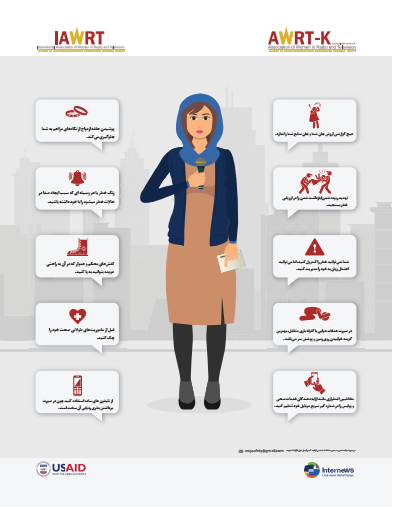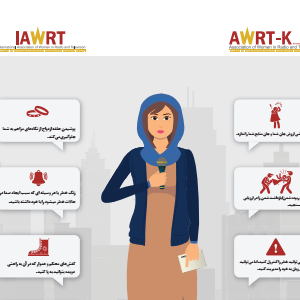Embedding Gender in Afghan Media
Promoting a New Generation of Female Media Leaders
By Maryam Bahar Sadat
A ceremony held in Kabul has marked the completion of IAWRT Afghanistan’s (AWRT-K) seven-month project to enhance the skills and influence of women journalists
The event opened with discussion of the project’s impact and the ideas of speakers from the leadership of the Afghanistan Journalists Federation. The USAID Rasana project was run in cooperation with the Afghanistan Women Journalists Union (AWJU) and the Centre for the Protection of Afghan Women Journalists (CPAWJ).

During the ceremony, the second-tier leaders of each organization which participated in different voluntary activities were awarded for their dedication to serving women journalists.
Pic: From Left to Right: Lida Ahmadi, Hajira Karimi, Laila Noorani, IAWRT Project Manager, Maryam Bahar Sadat, Shabnam Popalzai, Malala Maiwand and Freshta Faizi.
The Rasana Project with Internews involved two phases, the first, developing gender policy for the Federation of Afghan Media Associations and Entities and implementation of that policy, and secondly, the training of second-tier leaders.
The first activity was aimed at strengthening the presence and influence of women in the media within the federation, which is made up of 15 journalist unions and support groups.
 By firstly hosting a federation meeting, AWRT-K raised awareness of members about gender inclusion and facilitated discussion on gender inclusivity in federation policies along with strategies for implementation of the developed strategy.
By firstly hosting a federation meeting, AWRT-K raised awareness of members about gender inclusion and facilitated discussion on gender inclusivity in federation policies along with strategies for implementation of the developed strategy.
- An action plan for implementation of gender policy within the federation was developed and it is being followed up in each federation meeting until it’s practiced.
- AWRT-K worked with federation members to include gender inclusive policy in federation regulations and to ensure the implementation of policy across the board
- AWRT-K gained the commitment of federation members to implement the gender inclusive policy and developed a hotline email for complaints from women journalists all over Afghanistan which will be led by the three women journalist organizations (AWRT, AWJU, CPAWJ).
- Established a Gender Focal Point position to monitor the activities of the federation from a gender perspective. Ms. Farida Nikzad the Director of CPAWJ was assigned in cooperation with AWRT-K to act as a Gender Focal Point for the federation.
In the second activity, AWRT-K worked to develop second-tier leadership within women journalist support groups to ensure better representation of women as well as to sustain efforts within the federation to improve the status of women journalists.

- Through conducting a workshop on women journalist leadership skills, along with identifying the challenges of women journalist in Afghanistan. We selected six young women journalists as second-tier leaders from Kabul, Parwan and Nangarhar.
- A strategy for capacity building of second-tier leaders – developing their knowledge and leadership skills in the media sectors by assigning them small research projects, and through attending different programs, training and seminars, including short English courses.
- Two-page safety guideline brochure and a poster were developed by AWRT-K in local languages which will be disseminated all over Afghanistan for women journalists and media entities.
Pic right: IAWRT Afghanistan safety guideline poster for women journalists in the Dari language, with advice on how to keep tehmselves safe by following some small points, including wearing sensible footwear, a wedding ring to repel unwanted advances, staying in contact with employers and when to take shelter.
Other coverage








